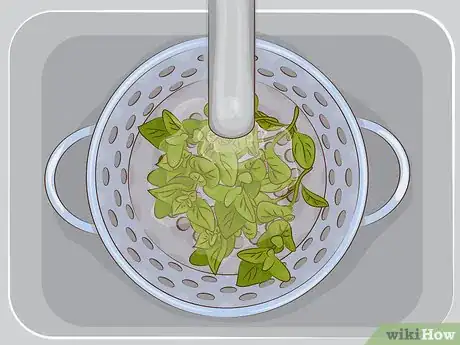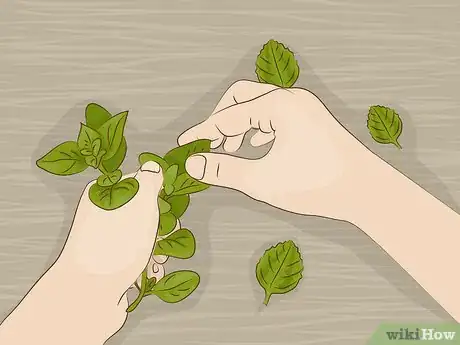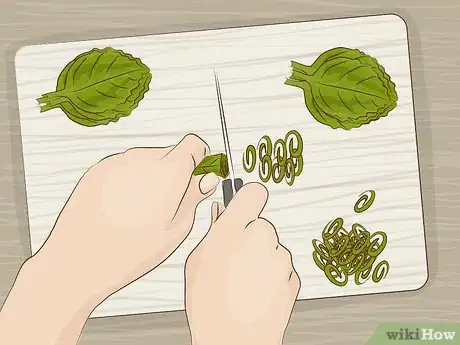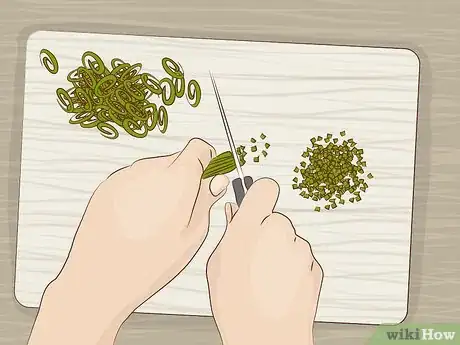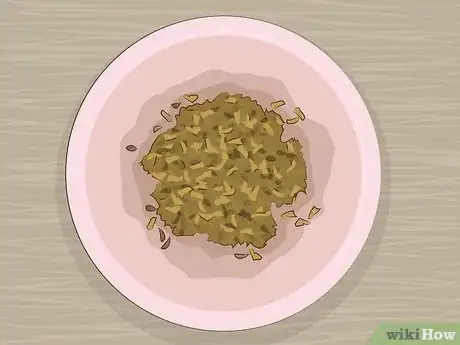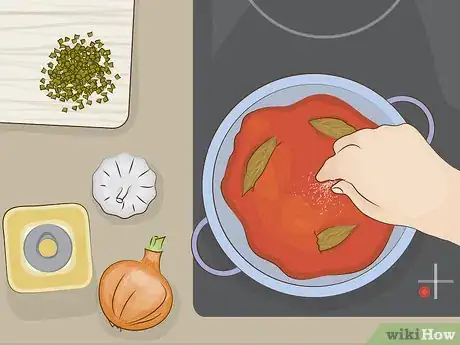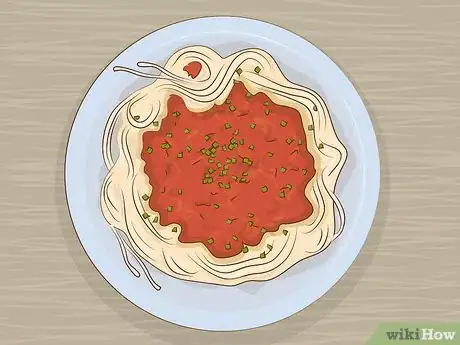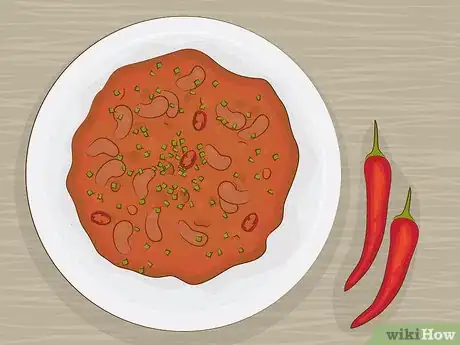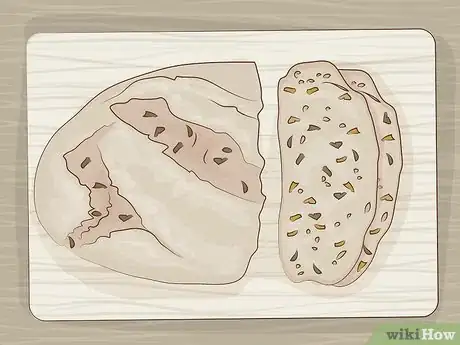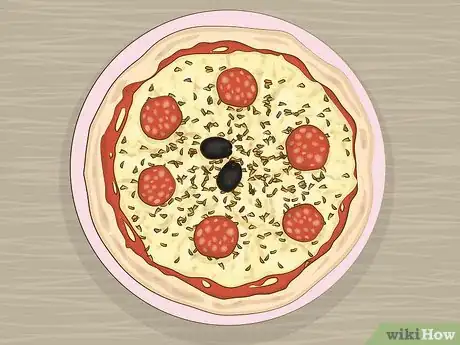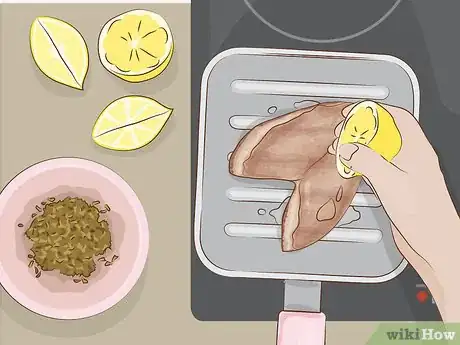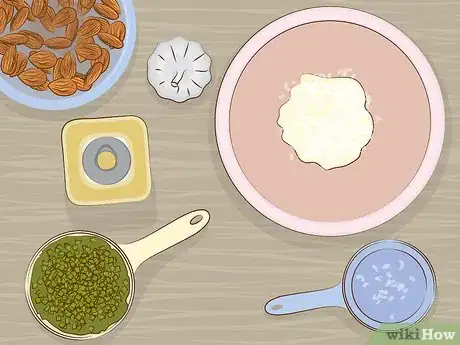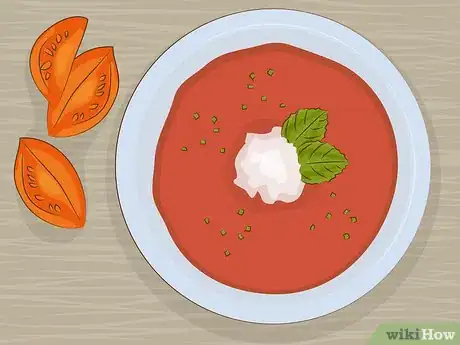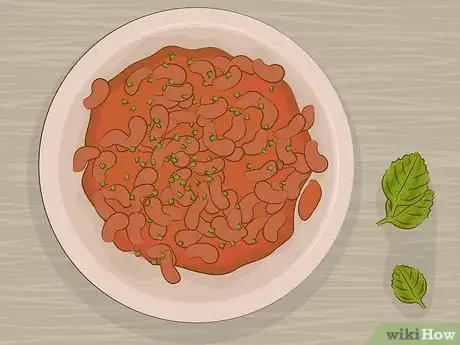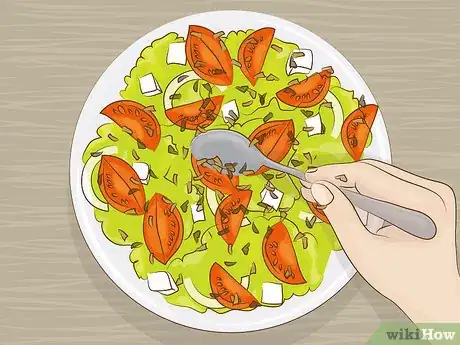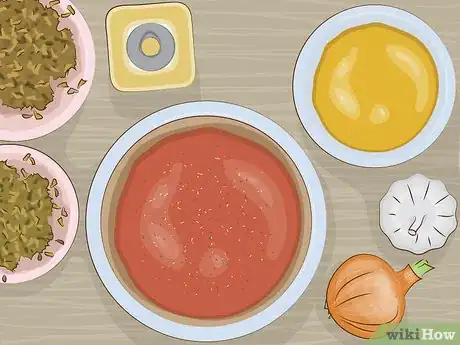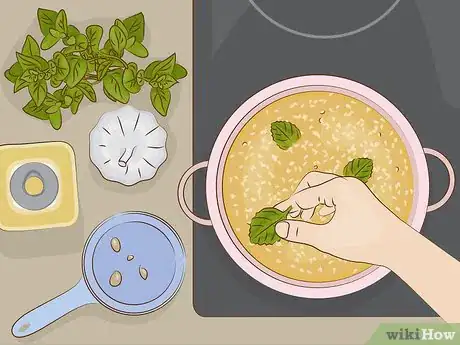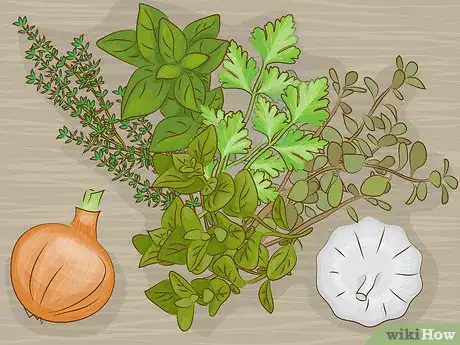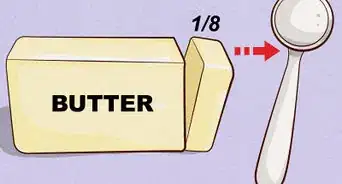This article was co-authored by Markeicha Dulaney. Chef Markeicha Dulaney is a Personal Chef and Founder of Sweet Monáe Personal Chef Services in 2015 in South Florida. She has over 22 years of experience in the kitchen and provides customizable menus to meet the dietary needs, taste preferences, style, and budget of each client. She also specializes in weekly in-home chef services, all-inclusive pro-chef services, boutique catering, and pantry organizing services. She was featured in The Knot's "Table for Two" YouTube episodes and has also been featured in Real Simple Magazine article on "What routines save you the most time.” Chef Markeicha Dulaney graduated with an Associate's Degree from the Pennsylvania Culinary Institute of Culinary Arts and is a longtime member of the USPCA (United States Personal Chef Association).
There are 12 references cited in this article, which can be found at the bottom of the page.
wikiHow marks an article as reader-approved once it receives enough positive feedback. In this case, several readers have written to tell us that this article was helpful to them, earning it our reader-approved status.
This article has been viewed 280,629 times.
Oregano's robust and woody taste makes a great addition to lots of dishes, especially those with meats and fresh vegetables, when it is added fresh or dried It pairs well with traditional Greek and Italian foods, but that doesn't mean you have to stop there! There are lots of ways you can use oregano in the kitchen, including in baking and cooking, in soups and salads, and even in dressings and oils. Though the easiest way to use oregano is to just sprinkle it into whatever you're making, you can also follow a few guidelines and recipes to bring out the flavor of this delicious herb and your meals!
Steps
Chopping Fresh Oregano
-
1Wash the fresh herbs. Oregano leaves are small and are attached to a woody stem that isn't pleasant to eat. Transfer the herbs to a colander and rinse them under running water to remove dirt and other matter from the garden. Drain the herbs and transfer them to a clean tea towel. Pat the leaves dry.
-
2Remove the leaves from the stems. Take a single sprig of oregano and pinch the top of the stem between your thumb and finger. Run your fingers down the stem to strip the leaves from the stem. Repeat with the other sprigs.[1]
- Instead of stripping the leaves from the stem, you can also trim the leaves off using scissors.
Advertisement -
3Stack and roll the leaves. Arrange the oregano leaves in piles of about 10, with the largest leaves on the bottom and the smaller leaves on top. One at a time, roll up each stack into a tight cylinder and hold it in place on a cutting board for chopping.[2]
- Stacking, rolling, and chopping herbs like this is a cutting technique known as chiffonade, which produces long, thin strips.
-
4Mince the leaves. Use a sharp knife to slice thin strips off the roll of oregano leaves. This will produce long strips of the herb. Arrange these strips lengthwise on the cutting board, and then dice the strips into small flecks to add to cooking and baking.[3]
-
5Try dried oregano in place of fresh. Instead of using fresh oregano in cooking and baking, you can also use dried oregano in its place. Dried oregano has a slightly stronger flavor, so you need less dried herb than you do fresh.
- Substitute 1 teaspoon (1.8 g) of dried oregano in place of 1 tablespoon (1.6 g) of fresh oregano.[4]
- Dried oregano should be added to dishes at the beginning of the cooking time to ensure it has time to infuse into the other ingredients. Fresh oregano can be added near the end of the cooking process to help preserve more of its flavor.[5]
Making Common Foods That Use Oregano
-
1Make a simple tomato sauce. Oregano and tomato are a classic combination, and there are many tomato-based dishes that you can add oregano to. A basic tomato sauce is a great way to use oregano, because you can add the sauce to pasta, pizza, sandwiches, chilis, soups, and more. To make the sauce:[6]
- In a large saucepan, cook a diced onion over medium heat with ¼ cup (59 ml) of olive oil, a bay leaf, 1 teaspoon (0.5 g) of fresh oregano, 2 cloves of minced garlic, and salt, to taste. Cook the mixture for 10 minutes.
- Add 2 tablespoons (28 g) of tomato paste and cook for another five minutes.
- Add two 28-ounce (794-g) cans of diced tomatoes and bring the mixture to a boil.
- When the sauce comes to a boil, lower the heat to medium-low and simmer it for an hour, stirring every few minutes.
- Remove the bay leaf and serve with your favorite dishes.
-
2Make a Bolognese sauce. Bolognese sauce is a creamy meat-based tomato sauce that’s often served with spaghetti. Making Bolognese sauce is very similar to making a basic tomato sauce, except for the addition of some extra ingredients, which include:[7]
- Celery
- Carrots
- Bacon or pancetta
- Veal
- Pork
- Whole milk
- White wine
-
3Add it to chili. Chili is another great tomato-based dish that you can add oregano to. Whether you prefer beef, turkey, or vegetarian chili, oregano always makes a great addition. You can either add 1 tablespoon (5.4 g) of dried oregano to the chili at the beginning of the cooking time, or add in 3 tablespoons (4.7 g) of fresh oregano to the pot in the last 15 minutes of cooking.
-
4Add herbs to your breads and baked goods. Homemade herb breads are delicious and they make your house smell wonderful. Oregano is an excellent addition to baked goods, and next time you make your own bread, scones, or crackers, consider kneading a tablespoon (5.4 g) of dried oregano into the dough before baking.
- To make an Italian herb blend for breads and baked goods, combine 1 tablespoon (5.4 g) each of dried basil and oregano, 1 teaspoon (3 g) each of garlic and onion powder, and ½ cup (63 g) of grated Romano cheese.[8]
-
5Season your pizza. Because oregano goes so well with bread and tomato, it’s no surprise that pizza just doesn’t taste the same without this herb. You can add oregano to any pizza by using an oregano and tomato sauce, or you can sprinkle some fresh oregano right over the ingredients before baking the pizza.
-
6Bake chicken with lemon and oregano. Chicken and oregano is a classic combination, and nothing goes better with these two ingredients than lemon. You can cook chicken, oregano, and lemon together any way you like, including baking or grilling. To make baked lemon-oregano chicken:[9]
- Combine in a small bowl ¼ cup (59 ml) of melted butter, ¼ cup (59 ml) of lemon juice, 2 tablespoons (30 ml) of Worcestershire sauce, and 2 tablespoons (30 ml) of soy sauce
- Transfer 6 skinless and boneless chicken breasts to a large baking dish
- Cover the chicken with the sauce
- Sprinkle 2 teaspoons (3.6 g) of dried oregano and 1 teaspoon (3 g) of garlic powder over the chicken
- Bake the chicken for 30 minutes in a 375 F (191 C) oven, pulling it out halfway through to baste the meat with the sauce
-
7Season other meats and fish. You can also use oregano to season turkey, fish, beef, and other meats. For turkey, stuff the cavity with three or four sprigs of fresh oregano before baking. For fish, bake or grill the fish with one or two sprigs of fresh oregano, and remove the sprigs before serving.[10] For beef, mix a tablespoon (1.6 g) of fresh oregano into 1 pound (454 g) of ground beef.[11]
- Oregano-seasoned ground beef is ideal for meatballs and burgers.
Finding Other Culinary Uses for Oregano
-
1Whip up an oregano pesto. Pesto is traditionally made with basil, but you can also make a fresh and tasty version with oregano. The pesto can be used as a spread, dip, pizza sauce, or even as a dressing for vegetables, salads, and potatoes. To make the pesto, pulse in a food processor until smooth:[12]
- 1 cup (25 g) of fresh oregano
- ½ cup (63 g) of grated parmesan cheese
- 1 large garlic clove
- ½ cup (63 g) of almonds
- ½ cup (118 ml) of olive oil
- Salt and pepper, to taste
-
2Put it in soups and stews. Oregano is a spicy and robust herb that you can use to add tons of flavor to any soup or stew, including tomato soup, vegetable soup, chicken soup or stew, beef stew, potato soup, or fish stew.
-
3Spice up your beans. Mexican oregano is a variety of oregano that has more citrusy notes, and this pairs extremely well with beans of all types. You can add 2 tablespoons (3 g) of fresh oregano to any bean dish, including baked beans, taco or burrito filling, hummus, falafel, and bean soups.[13]
-
4Season fresh or cooked vegetables. Vegetables and oregano are a classic combination, and you can use a single teaspoon (1.8 g) of dried oregano to spice up salads, roasted vegetables, steamed vegetables, or even veggie dips. Simply sprinkle the oregano on before serving, or stir the herb into your favorite dips.
-
5Make a Greek salad dressing. Greek dressing is an excellent way to use oregano, because it pairs the herb with a number of complementary flavors, such as olives and goat cheese. To make a delicious and versatile Greek dressing for salads, potatoes, and other vegetable dishes, whisk together:[16]
- 6 cups (1.4 L) olive oil
- ⅓ cup (48 g) garlic powder
- ⅓ cup (29 g) dried oregano
- ⅓ cup (29 g) dried basil
- ¼ cup (24 g) pepper
- ¼ cup (75 g) salt
- ¼ cup (36 g) onion powder
- ¼ cup (62 g) Dijon-style mustard
- 8 cups (1.9 L) red wine vinegar
-
6Infuse oil with oregano. Oregano-infused oil is a spicy oil that can be used for cooking, dressings, drizzles, marinades, dipping bread, and anything else that you'd use plain oil for. To infuse oil with oregano:[17]
- In a small saucepan, combine a cup (235 ml) of oil, 5 cloves of minced garlic, and 3 sprigs of fresh oregano
- Cook the mixture over low heat for 30 minutes
- Remove the pan from the heat and allow the oil to cool
- Strain out the garlic and oregano
- Transfer the oil to an airtight container and refrigerate it for up to a month
-
7Pair oregano with other spices. Oregano doesn’t have to be used on its own, and it actually complements a number of other herbs and spices very nicely. Some of the best and most popular spice pairings with oregano include:[18]
- Parsley
- Basil
- Thyme
- Garlic
- Onion
- Marjoram
Community Q&A
Did you know you can get answers researched by wikiHow Staff?
Unlock staff-researched answers by supporting wikiHow
-
QuestionWhat does oregano go well with?
 wikiHow Staff EditorThis answer was written by one of our trained team of researchers who validated it for accuracy and comprehensiveness.
wikiHow Staff EditorThis answer was written by one of our trained team of researchers who validated it for accuracy and comprehensiveness.
Staff Answer wikiHow Staff EditorStaff AnswerOregano goes well with lamb, chicken, seafood, tomatoes, eggplant and potatoes. It is a great addition to soups, stews and casseroles. Egg dishes can be enhanced by the addition of oregano. Oregano is a good addition whenever lemon is used in a savory dish. Finally, it's a useful and flavor enhancing addition to stuffing.
wikiHow Staff EditorStaff AnswerOregano goes well with lamb, chicken, seafood, tomatoes, eggplant and potatoes. It is a great addition to soups, stews and casseroles. Egg dishes can be enhanced by the addition of oregano. Oregano is a good addition whenever lemon is used in a savory dish. Finally, it's a useful and flavor enhancing addition to stuffing. -
QuestionWhich is better, dried or fresh oregano?
 wikiHow Staff EditorThis answer was written by one of our trained team of researchers who validated it for accuracy and comprehensiveness.
wikiHow Staff EditorThis answer was written by one of our trained team of researchers who validated it for accuracy and comprehensiveness.
Staff Answer wikiHow Staff EditorStaff AnswerBoth fresh and dried oregano play a useful role in cooking. Fresh oregano is a good choice when you have access to it readily but dried oregano keeps longer and can be used during all seasons. Dried oregano also tends to have a more potent flavor, so less is needed. Finally, some cooks prefer one over the other, so it's helpful to try each to make up your own mind. If you like dried oregano a lot, try drying your own at home, so it's fresh and of good quality.
wikiHow Staff EditorStaff AnswerBoth fresh and dried oregano play a useful role in cooking. Fresh oregano is a good choice when you have access to it readily but dried oregano keeps longer and can be used during all seasons. Dried oregano also tends to have a more potent flavor, so less is needed. Finally, some cooks prefer one over the other, so it's helpful to try each to make up your own mind. If you like dried oregano a lot, try drying your own at home, so it's fresh and of good quality. -
QuestionCan you suggest a way of adding oregano to potatoes?
 wikiHow Staff EditorThis answer was written by one of our trained team of researchers who validated it for accuracy and comprehensiveness.
wikiHow Staff EditorThis answer was written by one of our trained team of researchers who validated it for accuracy and comprehensiveness.
Staff Answer wikiHow Staff EditorStaff AnswerAn easy and long-used recipe for adding oregano potatoes is this simple one: Wash the potatoes; peeling is not necessary unless you want them peeled. Then toss the potatoes in a mixture of olive oil, lemon juice and fresh or dried oregano. Place in a baking dish and bake for an hour or so at around 350ºF/180ºC until baked. Remove and serve immediately; add a few sprigs of fresh oregano to the plate if wished.
wikiHow Staff EditorStaff AnswerAn easy and long-used recipe for adding oregano potatoes is this simple one: Wash the potatoes; peeling is not necessary unless you want them peeled. Then toss the potatoes in a mixture of olive oil, lemon juice and fresh or dried oregano. Place in a baking dish and bake for an hour or so at around 350ºF/180ºC until baked. Remove and serve immediately; add a few sprigs of fresh oregano to the plate if wished.
References
- ↑ https://www.youtube.com/watch?v=UM6-waGjSVs
- ↑ http://www.noreciperequired.com/technique/how-chop-fresh-oregano
- ↑ https://www.youtube.com/watch?v=UM6-waGjSVs
- ↑ http://www.herbexpert.co.uk/cooking-with-oregano.html
- ↑ https://www.youtube.com/watch?v=kQjOrW2Q8_c
- ↑ http://www.epicurious.com/recipes/food/views/classic-tomato-sauce-369172
- ↑ http://www.epicurious.com/recipes/food/views/bolognese-sauce-107226
- ↑ http://allrecipes.com/recipe/6784/italian-herb-bread-i/
- ↑ http://allrecipes.com/recipe/8730/oregano-chicken/
- ↑ https://www.thecitycook.com/articles/2009-10-15-oregano-fresh-vs-dried
- ↑ https://www.thekitchn.com/5-ways-to-use-fresh-oregano-from-your-garden-ingredient-spotlight-191094
- ↑ http://ahealthylifeforme.com/oregano-pesto/
- ↑ https://www.thekitchn.com/5-ways-to-use-fresh-oregano-from-your-garden-ingredient-spotlight-191094
- ↑ https://www.thecitycook.com/articles/2009-10-15-oregano-fresh-vs-dried
- ↑ https://www.thecitycook.com/articles/2009-10-15-oregano-fresh-vs-dried
- ↑ http://allrecipes.com/recipe/36520/absolutely-fabulous-greekhouse-dressing/
- ↑ https://www.thecitycook.com/articles/2009-10-15-oregano-fresh-vs-dried
- ↑ http://www.herbexpert.co.uk/cooking-with-oregano.html
About This Article
To use fresh oregano in cooking, start by washing the herbs and removing the leaves from the stems. Next, roll up the leaves before slicing them into long strips. Lay out the strips on the board and dice them into small pieces. If you want to add the oregano to a tomato sauce, fry the oregano with the onion before adding the tomatoes. Alternatively, add your fresh oregano to a pot of chili during the last 15 minutes of cooking or include the herb in your bread dough for some extra flavor. For tips on how to use dried oregano instead, or how to season your pizza with oregano, read on!
